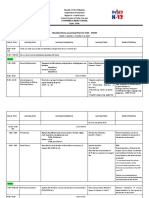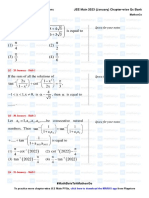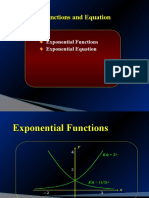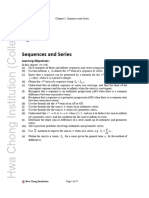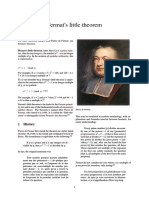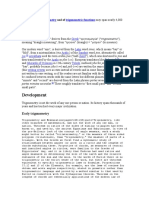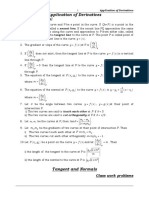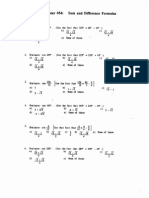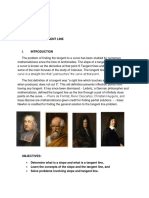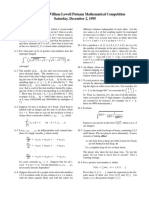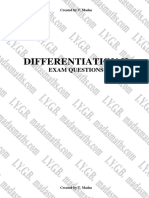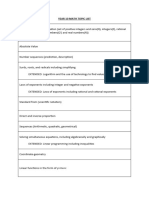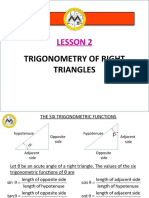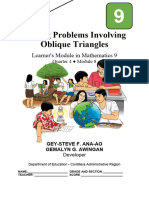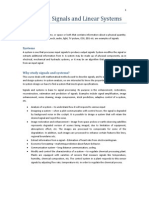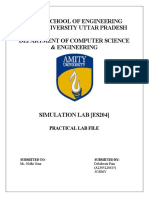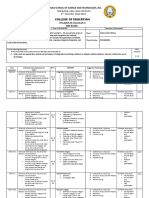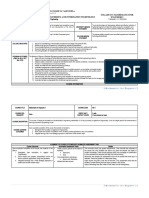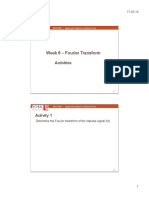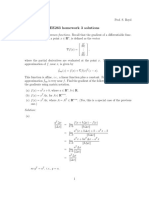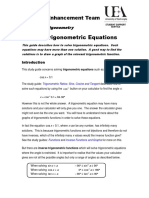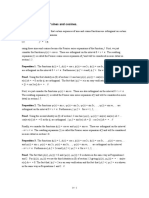Syllabus Math HL
Uploaded by
aritra97Syllabus Math HL
Uploaded by
aritra97Mathematics HL guide
17
1.1
Applications.
Sigma notation.
Sequences can be generated and displayed in
several ways, including recursive functions.
Arithmetic sequences and series; sum of finite
arithmetic series; geometric sequences and
series; sum of finite and infinite geometric
series.
Examples include compound interest and
population growth.
Link infinite geometric series with limits of
convergence in 6.1.
Further guidance
Content
The aim of this topic is to introduce students to some basic algebraic concepts and applications.
Topic 1Core: Algebra
Syllabus content
Syllabus
TOK: Mathematics and the knower. How is
mathematical intuition used as a basis for
formal proof? (Gauss method for adding up
integers from 1 to 100.)
(continued)
TOK: Mathematics and the world. Some
mathematical constants ( , e, , Fibonacci
numbers) appear consistently in nature. What
does this tell us about mathematical
knowledge?
TOK: Mathematics and the knower. To what
extent should mathematical knowledge be
consistent with our intuition?
Int: The use of several alphabets in
mathematical notation (eg first term and
common difference of an arithmetic sequence).
Int: Aryabhatta is sometimes considered the
father of algebra. Compare with
al-Khawarizmi.
Int: The chess legend (Sissa ibn Dahir).
Links
30 hours
18
1.3
1.2
Exponents and logarithms are further
developed in 2.4.
Exponents and logarithms.
Link to 5.6, binomial distribution.
The binomial theorem:
Proof of binomial theorem.
Circular arrangements.
Not required:
Permutations where some objects are identical.
expansion of (a + b) n , n .
n
The ability to find and n Pr using both the
r
formula and technology is expected. Link to
5.4.
Counting principles, including permutations
and combinations.
Change of base.
Laws of exponents; laws of logarithms.
Further guidance
Content
Aim 8: How many different tickets are
possible in a lottery? What does this tell us
about the ethics of selling lottery tickets to
those who do not understand the implications
of these large numbers?
Int: The properties of Pascals triangle were
known in a number of different cultures long
before Pascal (eg the Chinese mathematician
Yang Hui).
TOK: The nature of mathematics. The
unforeseen links between Pascals triangle,
counting methods and the coefficients of
polynomials. Is there an underlying truth that
can be found linking these?
TOK: The nature of mathematics and science.
Were logarithms an invention or discovery? (This
topic is an opportunity for teachers and students to
reflect on the nature of mathematics.)
Appl: Chemistry 18.1, 18.2 (calculation of pH
and buffer solutions).
Appl: Physics 7.2, 13.2 (radioactive decay and
nuclear physics).
(see notes above)
Aim 8: Short-term loans at high interest rates.
How can knowledge of mathematics result in
individuals being exploited or protected from
extortion?
Links
Syllabus content
Mathematics HL guide
Mathematics HL guide
Complex numbers: the number i= 1 ; the
terms real part, imaginary part, conjugate,
modulus and argument.
1.5
Sums, products and quotients of complex
numbers.
Cartesian form z= a + ib .
Links to a wide variety of topics, for example,
complex numbers, differentiation, sums of
series and divisibility.
Proof by mathematical induction.
1.4
When solving problems, students may need to
use technology.
Further guidance
Content
TOK: Mathematics and the world. Why does
i appear in so many fundamental laws of
physics?
TOK: The nature of mathematics. Has i
been invented or was it discovered?
TOK: Mathematics and the knower. Do the
words imaginary and complex make the
concepts more difficult than if they had
different names?
Appl: Concepts in electrical engineering.
Impedance as a combination of resistance and
reactance; also apparent power as a
combination of real and reactive powers. These
combinations take the form z= a + ib .
TOK: Knowledge communities. Who judges
the validity of a proof?
TOK: Knowledge claims in mathematics. Do
proofs provide us with completely certain
knowledge?
TOK: Nature of mathematics and science.
What are the different meanings of induction in
mathematics and science?
Links
Syllabus content
19
20
Proof by mathematical induction for n + .
Powers of complex numbers: de Moivres
theorem.
These systems should be solved using both
algebraic and technological methods, eg row
reduction.
Solutions of systems of linear equations (a
maximum of three equations in three
unknowns), including cases where there is a
unique solution, an infinity of solutions or no
solution.
1.9
Link to vectors in 4.7.
When a system has an infinity of solutions, a
general solution may be required.
Systems that have solution(s) may be referred
to as consistent.
Link to 2.5 and 2.7.
Conjugate roots of polynomial equations with
real coefficients.
nth roots of a complex number.
The complex plane is also known as the
Argand diagram.
The complex plane.
The ability to convert between forms is
expected.
r ei is also known as Eulers form.
Modulusargument (polar) form
z =r (cos + i sin ) =r cis =r ei .
1.8
1.7
1.6
Further guidance
Content
TOK: Mathematics, sense, perception and
reason. If we can find solutions in higher
dimensions, can we reason that these spaces
exist beyond our sense perception?
TOK: Reason and mathematics. What is
mathematical reasoning and what role does
proof play in this form of reasoning? Are there
examples of proof that are not mathematical?
TOK: Mathematics and the knower. Why
might it be said that ei + 1 =
0 is beautiful?
TOK: The nature of mathematics. Was the
complex plane already there before it was used
to represent complex numbers geometrically?
Appl: Concepts in electrical engineering.
Phase angle/shift, power factor and apparent
power as a complex quantity in polar form.
Links
Syllabus content
Mathematics HL guide
22 hours
2.1
Mathematics HL guide
Link with 3.4.
Link with 6.2.
One-to-one and many-to-one functions.
Inverse function f 1 , including domain
restriction. Self-inverse functions.
Identity function.
( f g )( x) = f ( g ( x)) . Link with 6.2.
TOK: The nature of mathematics. Is
mathematics simply the manipulation of
symbols under a set of formal rules?
Odd and even functions.
Composite functions f g .
Links
Int: The notation for functions was developed
by a number of different mathematicians in the
17th and 18th centuries. How did the notation
we use today become internationally accepted?
Further guidance
Concept of function f : x f ( x) : domain,
range; image (value).
Content
The aims of this topic are to explore the notion of function as a unifying theme in mathematics, and to apply functional methods to a variety of
mathematical situations. It is expected that extensive use will be made of technology in both the development and the application of this topic.
Topic 2Core: Functions and equations
Syllabus content
21
22
2.4
2.3
2.2
ax + b
, and its
cx + d
The function x log a x , x > 0 , and its graph.
The function x a x , a > 0 , and its graph.
graph.
The rational function x
The graph of the inverse function as a
reflection in y = x .
Transformations of graphs: translations;
stretches; reflections in the axes.
y = f ( x) .
1
The graph of y =
given the graph of
f ( x)
y = f(x).
The graphs of the functions y = f ( x) and
Investigation of key features of graphs, such as
maximum and minimum values, intercepts,
horizontal and vertical asymptotes and symmetry,
and consideration of domain and range.
The graph of a function; its equation y = f ( x) .
Content
Application of concepts in 2.1, 2.2 and 2.3.
Link to 6.2 and the significance of e.
Exponential and logarithmic functions as
inverses of each other.
Graphs should include both asymptotes and
any intercepts with axes.
The reciprocal function is a particular case.
Link to 3.4. Students are expected to be aware
of the effect of transformations on both the
algebraic expression and the graph of a
function.
Use of technology to graph a variety of
functions.
Further guidance
Appl: Geography SL/HL (geographic skills);
Physics SL/HL 7.2 (radioactive decay);
Chemistry SL/HL 16.3 (activation energy);
Economics SL/HL 3.2 (exchange rates).
Appl: Economics SL/HL 1.1 (shift in demand
and supply curves).
Int: Bourbaki group analytical approach versus
Mandlebrot visual approach.
Appl: Sketching and interpreting graphs;
Geography SL/HL (geographic skills);
Chemistry 11.3.1.
TOK: Mathematics and knowledge claims.
Does studying the graph of a function contain
the same level of mathematical rigour as
studying the function algebraically
(analytically)?
Links
Syllabus content
Mathematics HL guide
Mathematics HL guide
2.6
2.5
The relationship between the degree of a
polynomial function and the possible numbers
of x-intercepts.
The factor and remainder theorems.
Use of technology to solve a variety of
equations, including those where there is no
appropriate analytic approach.
Solution of a x = b using logarithms.
Sum and product of the roots of polynomial
equations.
Solving polynomial equations both graphically
and algebraically.
Use of the discriminant = b 4ac to
determine the nature of the roots.
(1) n a0
.
an
an 1
,
an
the product is
the sum is
For the polynomial equation
r =0
a x
n
r
=0,
Link the solution of polynomial equations to
conjugate roots in 1.8.
Solving quadratic equations using the quadratic May be referred to as roots of equations or
formula.
zeros of functions.
The fundamental theorem of algebra.
The graphical significance of repeated factors.
Further guidance
Polynomial functions and their graphs.
Content
Aim 8: The phrase exponential growth is
used popularly to describe a number of
phenomena. Is this a misleading use of a
mathematical term?
Appl: Physics (HL only) 9.1 (projectile
motion).
Appl: Physics 4.2 (energy changes in simple
harmonic motion).
Appl: Physics 2.1 (kinematics).
Appl: Chemistry 17.2 (equilibrium law).
Links
Syllabus content
23
2.7
24
Use of technology for these and other functions.
Graphical or algebraic methods, for simple
polynomials up to degree 3.
Solutions of g ( x) f ( x) .
Content
Further guidance
Links
Syllabus content
Mathematics HL guide
22 hours
Mathematics HL guide
3.3
3.2
3.1
, , , and their multiples.
6 4 3 2
Not required:
Proof of compound angle identities.
Double angle identities.
Compound angle identities.
Pythagorean identities: cos 2 + sin 2 =
1;
2
2
2
2
1 + tan =
sec ; 1 + cot =
csc .
Definition of the reciprocal trigonometric
ratios sec , csc and cot .
0,
Exact values of sin, cos and tan of
Definition of cos , sin and tan in terms
of the unit circle.
Length of an arc; area of a sector.
Finding possible values of trigonometric ratios
without finding , for example, finding sin 2
given sin .
Derivation of double angle identities from
compound angle identities.
(continued)
Appl: Concepts in electrical engineering.
Generation of sinusoidal voltage.
Int: Why did Pythagoras link the study of
music and mathematics?
Appl: Triangulation used in the Global
Positioning System (GPS).
Appl: Physics SL/HL 2.2 (forces and
dynamics).
Int: The origin of the word sine.
TOK: Mathematics and knowledge claims. If
trigonometry is based on right triangles, how
can we sensibly consider trigonometric ratios
of angles greater than a right angle?
TOK: Mathematics and the knower. Why do
we use radians? (The arbitrary nature of degree
measure versus radians as real numbers and the
implications of using these two measures on
the shape of sinusoidal graphs.)
Radian measure may be expressed as multiples Int: The origin of degrees in the mathematics
of , or decimals. Link with 6.2.
of Mesopotamia and why we use minutes and
seconds for time.
The circle: radian measure of angles.
Links
Further guidance
Content
The aims of this topic are to explore the circular functions, to introduce some important trigonometric identities and to solve triangles using trigonometry.
.
On examination papers, radian measure should be assumed unless otherwise indicated, for example, by x sin x
Topic 3Core: Circular functions and trigonometry
Syllabus content
25
26
3.7
Algebraic and graphical methods of solving
trigonometric equations in a finite interval,
including the use of trigonometric identities
and factorization.
3.6
Applications.
Area of a triangle as
1
ab sin C .
2
The sine rule including the ambiguous case.
The cosine rule
Not required:
The general solution of trigonometric
equations.
The inverse functions x arcsin x ,
x arccos x , x arctan x ; their domains and
ranges; their graphs.
Applications.
Composite functions of the form
f=
( x) a sin(b( x + c)) + d .
3.5
3.4
Content
Examples include navigation, problems in two
and three dimensions, including angles of
elevation and depression.
Further guidance
Int: The use of triangulation to find the
curvature of the Earth in order to settle a
dispute between England and France over
Newtons gravity.
Appl: Physics SL/HL 1.3 (vectors and scalars);
Physics SL/HL 2.2 (forces and dynamics).
TOK: Nature of mathematics. If the angles of
a triangle can add up to less than 180, 180 or
more than 180, what does this tell us about the
fact of the angle sum of a triangle and about
the nature of mathematical knowledge?
TOK: Mathematics and knowledge claims.
How can there be an infinite number of
discrete solutions to an equation?
Appl: Physics SL/HL 4.1 (kinematics of
simple harmonic motion).
(see notes above)
TOK: Mathematics and the world. Music can
be expressed using mathematics. Does this
mean that music is mathematical, that
mathematics is musical or that both are
reflections of a common truth?
Links
Syllabus content
Mathematics HL guide
24 hours
4.1
Mathematics HL guide
magnitude of a vector, v ;
position vectors OA = a .
AB= b a
multiplication by a scalar, kv ;
the zero vector 0 , the vector v ;
the sum and difference of two vectors;
Algebraic and geometric approaches to the
following:
v1
v = v2 =v1i + v2 j + v3 k .
v
3
Components of a vector:
Unit vectors; base vectors i, j, k.
Representation of vectors using directed line
segments.
Concept of a vector.
Content
magnitude of AB .
Distance between points A and B is the
Proofs of geometrical properties using vectors.
Further guidance
TOK: Mathematics and knowledge claims.
You can perform some proofs using different
mathematical concepts. What does this tell us
about mathematical knowledge?
Appl: Physics SL/HL 1.3 (vectors and scalars);
Physics SL/HL 2.2 (forces and dynamics).
Aim 8: Vectors are used to solve many
problems in position location. This can be used
to save a lost sailor or destroy a building with a
laser-guided bomb.
Links
The aim of this topic is to introduce the use of vectors in two and three dimensions, and to facilitate solving problems involving points, lines and planes.
Topic 4Core: Vectors
Syllabus content
27
28
4.4
4.3
4.2
For parallel vectors, v w =
v w.
(kv ) w = k (v w ) ;
TOK: The nature of mathematics. Why might
it be argued that vector representation of lines
is superior to Cartesian?
=
x x0 + l , =
y y0 + m , =
z z0 + n .
The angle between two lines.
Points of intersection.
Coincident, parallel, intersecting and skew
lines; distinguishing between these cases.
Appl: Navigational devices, eg GPS.
Parametric form:
Simple applications to kinematics.
x x0 y y0 z z0
.
= =
l
m
n
Cartesian form:
Appl: Modelling linear motion in three
dimensions.
Knowledge of the following forms for
equations of lines.
TOK: The nature of mathematics. Why this
definition of scalar product?
Appl: Physics SL/HL 2.2 (forces and
dynamics).
Links
Vector equation of a line in two and three
dimensions: r = a + b .
Perpendicular vectors; parallel vectors.
The angle between two vectors.
v v =v .
For non-zero vectors, v w =
0 is equivalent to
the vectors being perpendicular.
u (v + w ) = u v + u w ;
v w = w v ;
Link to 3.6.
vw =
v w cos , where is the angle
between v and w .
The definition of the scalar product of two
vectors.
Properties of the scalar product:
Further guidance
Content
Syllabus content
Mathematics HL guide
Mathematics HL guide
4.7
4.6
4.5
Angle between: a line and a plane; two planes.
Intersections of: a line with a plane; two
planes; three planes.
Cartesian equation of a plane ax + by + cz =
d.
Use of normal vector to obtain the form
r n =a n.
Vector equation of a plane r =a + b + c .
Geometric interpretation of v w .
vv =
0.
(kv ) w = k (v w ) ;
u (v + w ) = u v + u w ;
v w = w v ;
Properties of the vector product:
The definition of the vector product of two
vectors.
Content
Geometrical interpretation of solutions.
Link to 1.9.
Areas of triangles and parallelograms.
vw =
v w sin n , where is the angle
between v and w and n is the unit normal
vector whose direction is given by the righthand screw rule.
Further guidance
TOK: Mathematics and the knower. Why are
symbolic representations of three-dimensional
objects easier to deal with than visual
representations? What does this tell us about
our knowledge of mathematics in other
dimensions?
Appl: Physics SL/HL 6.3 (magnetic force and
field).
Links
Syllabus content
29
30
36 hours
5.1
Not required:
Estimation of mean and variance of a
population from a sample.
Mean, variance, standard deviation.
i i
n
i
)2
=
n
i =1
f (x
i =1
fx
i =1
i i
fx
2
.
2
In examinations the following formulae should
be used:
For examination purposes, in papers 1 and 2
data will be treated as the population.
Concepts of population, sample, random
sample and frequency distribution of discrete
and continuous data.
Grouped data: mid-interval values, interval
width, upper and lower interval boundaries.
Further guidance
Content
Appl: Misleading statistics in media reports.
Appl: Methods of collecting data in real life
(census versus sampling).
Appl: Psychology SL/HL (descriptive
statistics); Geography SL/HL (geographic
skills); Biology SL/HL 1.1.2 (statistical
analysis).
Aim 8: Does the use of statistics lead to an
overemphasis on attributes that can easily be
measured over those that cannot?
TOK: The nature of knowing. Is there a
difference between information and data?
TOK: The nature of mathematics. Why have
mathematics and statistics sometimes been
treated as separate subjects?
Links
The aim of this topic is to introduce basic concepts. It may be considered as three parts: manipulation and presentation of statistical data (5.1), the laws of
probability (5.25.4), and random variables and their probability distributions (5.55.7). It is expected that most of the calculations required will be done on
a GDC. The emphasis is on understanding and interpreting the results obtained. Statistical tables will no longer be allowed in examinations.
Topic 5Core: Statistics and probability
Syllabus content
Mathematics HL guide
Mathematics HL guide
5.4
5.3
5.2
Use of Bayes theorem for a maximum of three
events.
Independent events; the definition
P ( A=
| B ) P=
( A ) P ( A | B ) .
Conditional probability; the definition
P( A B )
.
P( A | B) =
P( B )
Mutually exclusive events.
Combined events; the formula for P( A B ) .
Use of Venn diagrams, tree diagrams, counting
principles and tables of outcomes to solve
problems.
The complementary events A and A (not A).
Concepts of trial, outcome, equally likely
outcomes, sample space (U) and event.
n( A)
.
The probability of an event A as P( A) =
n(U )
Content
Use of P( A B ) =
P( A)P( B ) to show
independence.
Further guidance
TOK: Mathematics and knowledge claims. Is
independence as defined in probabilistic terms
the same as that found in normal experience?
Appl: Use of probability methods in medical
studies to assess risk factors for certain
diseases.
Int: The development of the mathematical
theory of probability in 17th century France.
Aim 8: Why has it been argued that theories
based on the calculable probabilities found in
casinos are pernicious when applied to
everyday life (eg economics)?
Links
Syllabus content
31
32
5.7
5.6
5.5
Standardization of normal variables.
Properties of the normal distribution.
Normal distribution.
Not required:
Formal proof of means and variances.
Poisson distribution, its mean and variance.
TOK: Mathematics and the real world. Is the
binomial distribution ever a useful model for
Conditions under which random variables have
an actual real-world situation?
these distributions.
Binomial distribution, its mean and variance.
Int: De Moivres derivation of the normal
distribution and Quetelets use of it to describe
lhomme moyen.
TOK: Mathematics and knowledge claims. To
what extent can we trust mathematical models
such as the normal distribution?
Probabilities and values of the variable must be Appl: Chemistry SL/HL 6.2 (collision theory);
found using technology.
Psychology HL (descriptive statistics); Biology
SL/HL 1.1.3 (statistical analysis).
The standardized value (z) gives the number of
standard deviations from the mean.
Aim 8: Why might the misuse of the normal
distribution lead to dangerous inferences and
Link to 2.3.
conclusions?
Link to binomial theorem in 1.3.
Examples include games of chance.
Applications.
Appl: Expected gain to insurance companies.
TOK: Mathematics and the knower. To what
extent can we trust samples of data?
Links
For a continuous random variable, a value at
which the probability density function has a
maximum value is called a mode.
Further guidance
Expected value (mean), mode, median,
variance and standard deviation.
Definition and use of probability density functions.
Concept of discrete and continuous random
variables and their probability distributions.
Content
Syllabus content
Mathematics HL guide
6.1
Mathematics HL guide
f ( x + h) f ( x )
.
h
Higher derivatives.
The second derivative.
Identifying increasing and decreasing
functions.
Finding equations of tangents and normals.
The derivative interpreted as a gradient
function and as a rate of change.
h 0
f ( x) = lim
Definition of derivative from first principles
sin
=1.
dy
and f ( x ) , for the
dx
d2 y
and f ( x) , for
dx 2
Familiarity with the notation
dn y
and
dx n
f ( n ) ( x) . Link with induction in 1.4.
the second derivative.
Both forms of notation,
Use of both algebra and technology.
first derivative.
Both forms of notation,
Link to binomial theorem in 1.3.
Use of this definition for polynomials only.
Link to 1.1.
Include result lim
Informal ideas of limit, continuity and
convergence.
0
Further guidance
Content
48 hours
Appl: Economics HL 1.5 (theory of the firm);
Chemistry SL/HL 11.3.4 (graphical
techniques); Physics SL/HL 2.1 (kinematics).
TOK: Mathematics and the knower. What
does the dispute between Newton and Leibniz
tell us about human emotion and mathematical
discovery?
Int: Investigate attempts by Indian
mathematicians (5001000 CE) to explain
division by zero.
Int: How the Greeks distrust of zero meant
that Archimedes work did not lead to calculus.
TOK: The nature of mathematics. Does the
fact that Leibniz and Newton came across the
calculus at similar times support the argument
that mathematics exists prior to its discovery?
Links
The aim of this topic is to introduce students to the basic concepts and techniques of differential and integral calculus and their application.
Topic 6Core: Calculus
Syllabus content
33
34
6.3
6.2
Use of the terms concave up for f ( x) > 0 ,
concave down for f ( x) < 0 .
Testing for the maximum or minimum using
the change of sign of the first derivative and
using the sign of the second derivative.
defined, for example, y = x1 3 at (0,0) .
Not required:
Points of inflexion, where f ( x) is not
Graphical behaviour of functions, including the
relationship between the graphs of
At a point of inflexion, f ( x) = 0 and changes
f , f and f .
sign (concavity change).
Points of inflexion with zero and non-zero
gradients.
Optimization problems.
Local maximum and minimum values.
Derivatives of sec x , csc x , cot x , a x , log a x ,
arcsin x , arccos x and arctan x .
Implicit differentiation.
Related rates of change.
The chain rule for composite functions.
The product and quotient rules.
TOK: Mathematics and the real world. The
seemingly abstract concept of calculus allows us
to create mathematical models that permit human
feats, such as getting a man on the Moon. What
does this tell us about the links between
mathematical models and physical reality?
TOK: Mathematics and knowledge claims.
Euler was able to make important advances in
mathematical analysis before calculus had been
put on a solid theoretical foundation by Cauchy
and others. However, some work was not
possible until after Cauchys work. What does
this tell us about the importance of proof and
the nature of mathematics?
Differentiation of sums and multiples of
functions.
Links
Appl: Physics HL 2.4 (uniform circular motion);
Physics 12.1 (induced electromotive force (emf)).
Further guidance
Derivatives of x n , sin x , cos x , tan x , e x and
ln x .
Content
Syllabus content
Mathematics HL guide
Mathematics HL guide
Anti-differentiation with a boundary condition
to determine the constant of integration.
6.5
Volumes of revolution about the x-axis or y-axis.
Area of the region enclosed by a curve and the
x-axis or y-axis in a given interval; areas of
regions enclosed by curves.
The value of some definite integrals can only
be found using technology.
Indefinite integral interpreted as a family of
curves.
Indefinite integral of x n , sin x , cos x and e x .
1
dx ln x + c .
=
Other indefinite integrals using the results from x
6.2.
5
1
Examples include ( 2 x 1) dx ,
dx
The composites of any of these with a linear
3x + 4
function.
1
and 2
dx .
x + 2x + 5
Definite integrals.
Indefinite integration as anti-differentiation.
Further guidance
6.4
Content
Appl: Industrial design.
Links
Syllabus content
35
36
6.7
6.6
t2
ds
dv d 2 s
dv
,=
a = =
v .
2
dt
dt dt
ds
Examples:
2 x
x e
dx and e x sin x dx .
Repeated integration by parts.
x sin x dx and ln x dx .
Link to 6.2.
Integration by parts.
Examples:
On examination papers, non-standard
substitutions will be provided.
t1
Total distance travelled = v dt .
v=
Further guidance
Integration by substitution
Total distance travelled.
Kinematic problems involving displacement s,
velocity v and acceleration a.
Content
Int: Does the inclusion of kinematics as core
mathematics reflect a particular cultural
heritage? Who decides what is mathematics?
Appl: Physics HL 2.1 (kinematics).
Links
Syllabus content
Mathematics HL guide
48 hours
Mathematics HL guide
7.2
7.1
Expectation of the product of independent
random variables.
Variance of linear combinations of n
independent random variables.
E( XY ) = E( X )E(Y ) .
Var(aX + b) =
a 2 Var( X ) .
x)t x .
Mean of linear combinations of n random
variables.
P( X
=
E(aX +=
b) aE( X ) + b ,
=
G (t ) E(
=
tX )
Further guidance
Linear transformation of a single random variable.
Using probability generating functions to find
mean, variance and the distribution of the sum
of n independent random variables.
Probability generating functions for discrete
random variables.
Negative binomial distribution.
Geometric distribution.
Cumulative distribution functions for both
discrete and continuous distributions.
Content
Aim 8: Statistical compression of data files.
Int: Also known as Pascals distribution.
Links
The aims of this option are to allow students the opportunity to approach statistics in a practical way; to demonstrate a good level of statistical
understanding; and to understand which situations apply and to interpret the given results. It is expected that GDCs will be used throughout this option, and
that the minimum requirement of a GDC will be to find probability distribution function (pdf), cumulative distribution function (cdf), inverse cumulative
distribution function, p-values and test statistics, including calculations for the following distributions: binomial, Poisson, normal and t. Students are
expected to set up the problem mathematically and then read the answers from the GDC, indicating this within their written answers. Calculator-specific or
brand-specific language should not be used within these explanations.
Topic 7Option: Statistics and probability
Syllabus content
37
38
7.4
7.3
The central limit theorem.
A linear combination of independent normal
random variables is normally distributed. In
particular,
2
X ~ N( , 2 ) X ~ N , .
n
S 2 as an unbiased estimator for 2 .
X as an unbiased estimator for .
n
i =1
S =
2
i =1
X =
(X
X)
n 1
Xi
.
n
2
T1 is a more efficient estimator than T2 if
Var(T1 ) < Var(T2 ) .
TOK: Nature of mathematics. The central
limit theorem can be proved mathematically
(formalism), but its truth can be confirmed by
its applications (empiricism).
Aim 8/TOK: Mathematics and the world.
Without the central limit theorem, there could
be no statistics of any value within the human
sciences.
TOK: Mathematics and the world. In the
absence of knowing the value of a parameter,
will an unbiased estimator always be better
than a biased one?
T is an unbiased estimator for the parameter
if E(T ) = .
Unbiased estimators and estimates.
Comparison of unbiased estimators based on
variances.
Links
Further guidance
Content
Syllabus content
Mathematics HL guide
Mathematics HL guide
Testing hypotheses for the mean of a normal
population.
Type I and II errors, including calculations of
their probabilities.
Critical regions, critical values, p-values, onetailed and two-tailed tests.
Significance level.
Null and alternative hypotheses, H 0 and H1 .
7.6
Use of the normal distribution when is
known and use of the t-distribution when is
unknown, regardless of sample size. The case
of matched pairs is to be treated as an example
of a single sample technique.
TOK: Mathematics and the world. Claiming
brand A is better on average than brand B
can mean very little if there is a large overlap
between the confidence intervals of the two
means.
Use of the normal distribution when is
known and use of the t-distribution when is
unknown, regardless of sample size. The case
of matched pairs is to be treated as an example
of a single sample technique.
Confidence intervals for the mean of a normal
population.
7.5
Appl: When is it more important not to make a
Type I error and when is it more important not
to make a Type II error?
TOK: Mathematics and the world. Does the
ability to test only certain parameters in a
population affect the way knowledge claims in
the human sciences are valued?
TOK: Mathematics and the world. In practical
terms, is saying that a result is significant the
same as saying that it is true?
Appl: Geography.
Links
Further guidance
Content
Syllabus content
39
7.7
40
Cov( X , Y ) = E[( X x )(Y y )]
Covariance and (population) product moment
correlation coefficient .
Definition of the (sample) product moment
correlation coefficient R in terms of n paired
observations on X and Y. Its application to the
estimation of .
Proof that = 0 in the case of independence
and 1 in the case of a linear relationship
between X and Y.
Informal discussion of commonly occurring
situations, eg marks in pure mathematics and
statistics exams taken by a class of students,
salary and age of teachers in a certain school.
The need for a measure of association between
the variables and the possibility of predicting
the value of one of the variables given the
value of the other variable.
Introduction to bivariate distributions.
Cov( X , Y )
.
Var( X )Var(Y )
R=
i =1
i i
i =1
i =1
X Y nXY
X )(Yi Y )
X ) 2 (Yi Y ) 2
n 2
2
2
2
X i n X Yi nY
i =1
i =1
(X
(X
The use of as a measure of association
between X and Y, with values near 0 indicating
a weak association and values near +1 or near
1 indicating a strong association.
where
=
x E(
=
X ), y E(Y ) .
= E( XY ) x y ,
Further guidance
Content
(continued)
Aim 8: The physicist Frank Oppenheimer
wrote: Prediction is dependent only on the
assumption that observed patterns will be
repeated. This is the danger of extrapolation.
There are many examples of its failure in the
past, eg share prices, the spread of disease,
climate change.
TOK: Mathematics and the world. Given that a
set of data may be approximately fitted by a
range of curves, where would we seek for
knowledge of which equation is the true
model?
Appl: Using technology to fit a range of curves
to a set of data.
Aim 8: The correlation between smoking and
lung cancer was discovered using
mathematics. Science had to justify the cause.
Appl: Geographic skills.
Links
Syllabus content
Mathematics HL guide
Further guidance
Mathematics HL guide
( xi x )( yi y )
i =1
xx =
(y y)
n
2
y
(
)
i
i =1
n
xi yi nx y
( y y ),
= i =1n
2
2
yi n y
i =1
( xi x )( yi y )
yy =
i =1 n
(x x )
2
( xi x )
i =1
n
xi yi n x y
= i =1n
( x x ).
2
2
xi n x
i =1
Knowledge of the facts that the regression of X
on Y ( E( X ) | Y = y ) and Y on X ( E(Y ) | X = x )
are linear.
The use of these regression lines to predict the
value of one of the variables given the value of
the other.
Least-squares estimates of these regression
lines (proof not required).
n2
has the students t-distribution with
1 R2
(n 2) degrees of freedom.
Use of the t-statistic to test the null hypothesis
= 0.
R
It is expected that the GDC will be used
wherever possible in the following work.
The following topics are based on the
assumption of bivariate normality.
Informal interpretation of r, the observed value Values of r near 0 indicate a weak association
of R. Scatter diagrams.
between X and Y, and values near 1 indicate a
strong association.
Content
Links
(see notes above)
Syllabus content
41
42
48 hours
8.3
8.2
8.1
Further guidance
TOK: Cantor theory of transfinite numbers,
Russells paradox, Godels incompleteness
theorems.
Links
The term codomain.
Knowledge that the function composition is not
a commutative operation and that if f is a
Functions: injections; surjections; bijections.
Composition of functions and inverse
functions.
bijection from set A to set B then f 1 exists
and is a bijection from set B to set A.
An equivalence relation on a set forms a
partition of the set.
Relations: equivalence relations; equivalence
classes.
Ordered pairs: the Cartesian product of two sets.
Appl, Int: Scottish clans.
De Morgans laws: distributive, associative and Illustration of these laws using Venn diagrams. Appl: Logic, Boolean algebra, computer
commutative laws (for union and intersection).
circuits.
Students may be asked to prove that two sets are
the same by establishing that A B and B A .
Operations on sets: union; intersection;
complement; set difference; symmetric
difference.
Finite and infinite sets. Subsets.
Content
The aims of this option are to provide the opportunity to study some important mathematical concepts, and introduce the principles of proof through
abstract algebra.
Topic 8Option: Sets, relations and groups
Syllabus content
Mathematics HL guide
Mathematics HL guide
The identity element e.
8.6
Proofs of the uniqueness of the identity and
inverse elements.
Proof that left-cancellation and rightcancellation by an element a hold, provided
that a has an inverse.
The inverse a 1 of an element a.
Binary operations: associative, distributive and
commutative properties.
Operation tables (Cayley tables).
Binary operations.
8.5
8.4
Content
Both a a 1 =
e and a 1 a =
e must hold.
Both the right-identity a e =
a and leftidentity e a =
a must hold if e is an identity
element.
Examples of distributivity could include the
fact that, on , multiplication is distributive
over addition but addition is not distributive
over multiplication.
The arithmetic operations on and .
A binary operation on a non-empty set S is a
rule for combining any two elements a, b S
to give a unique element c. That is, in this
definition, a binary operation on a set is not
necessarily closed.
Further guidance
TOK: Which are more fundamental, the
general models or the familiar examples?
Links
Syllabus content
43
44
8.9
8.8
8.7
integers under addition modulo n;
non-zero integers under multiplication,
modulo p, where p is prime;
Proof that all cyclic groups are Abelian.
Generators.
Cyclic groups.
The order of a group element.
The order of a group.
invertible functions under composition of
functions.
symmetries of plane figures, including
equilateral triangles and rectangles;
, , and under addition;
Examples of groups:
Abelian groups.
The operation table of a group is a Latin
square, but the converse is false.
The definition of a group {G , } .
Content
is associative;
G contains an identity element;
each element in G has an inverse in G.
The composition T2 T1 denotes T1 followed
by T2 .
a b = b a , for all a, b G .
G is closed under ;
Appl: Music circle of fifths, prime numbers.
Appl: Rubiks cube, time measures, crystal
structure, symmetries of molecules, strut and
cable constructions, Physics H2.2 (special
relativity), the 8fold way, supersymmetry.
Appl: Galois theory for the impossibility of
such formulae for polynomials of degree 5 or
higher.
Appl: Existence of formula for roots of
polynomials.
For the set G under a given operation :
Links
Further guidance
Syllabus content
Mathematics HL guide
Mathematics HL guide
8.11
8.10
Further guidance
Use and proof of the result that the order of a
finite group is divisible by the order of any
element. (Corollary to Lagranges theorem.)
Lagranges theorem.
Definition and examples of left and right cosets
of a subgroup of a group.
Suppose that {G , } is a group and H is a
non-empty subset of G. Then {H , } is a
Use and proof of subgroup tests.
Suppose that {G , } is a finite group and H is a
non-empty subset of G. Then {H , } is a
subgroup of {G , } if H is closed under .
subgroup of {G , } if a b 1 H whenever
a, b H .
A proper subgroup is neither the group itself
nor the subgroup containing only the identity
element.
Subgroups, proper subgroups.
The order of a combination of cycles.
On examination papers: the form
1 2 3
p=
or in cycle notation (132) will
Cycle notation for permutations.
3 1 2
Result that every permutation can be written as be used to represent the permutation 1 3 ,
2 1 , 3 2.
a composition of disjoint cycles.
Permutations under composition of
permutations.
Content
Appl: Prime factorization, symmetry breaking.
Appl: Cryptography, campanology.
Links
Syllabus content
45
8.12
46
Infinite groups as well as finite groups.
Definition of a group homomorphism.
The order of an element is unchanged by an
isomorphism.
Isomorphism of groups.
for all a G .
The homomorphism f : G H is an
isomorphism if f is bijective.
Infinite groups as well as finite groups.
Identity: let eG and eH be the identity elements
of (G, ) and ( H , ) , respectively, then
f (eG ) = eH .
Proof of homomorphism properties for
identities and inverses.
Inverse: f (a 1 ) = ( f (a ) )
If f : G H is a group homomorphism, then
Ker( f ) is the set of a G such that
f (a ) = eH .
Definition of the kernel of a homomorphism.
Proof that the kernel and range of a
homomorphism are subgroups.
Let {G ,*} and {H , } be groups, then the
function f : G H is a homomorphism if
f (a * b) = f (a ) f (b) for all a, b G .
Further guidance
Content
Links
Syllabus content
Mathematics HL guide
Mathematics HL guide
Convergence of infinite series.
9.2
Power series: radius of convergence and
interval of convergence. Determination of the
radius of convergence by the ratio test.
Alternating series.
Series that converge conditionally.
Series that converge absolutely.
The p-series,
Tests for convergence: comparison test; limit
comparison test; ratio test; integral test.
Informal treatment of limit of sum, difference,
product, quotient; squeeze theorem.
Infinite sequences of real numbers and their
convergence or divergence.
9.1
is convergent for p > 1 and divergent
The absolute value of the truncation error is
less than the next term in the series.
Conditions for convergence.
otherwise. When p = 1 , this is the harmonic series.
then the series is not necessarily convergent,
but if lim xn 0 , the series diverges.
Students should be aware that if lim xn = 0
The sum of a series is the limit of the sequence
of its partial sums.
Divergent is taken to mean not convergent.
Further guidance
Content
48 hours
TOK: Eulers idea that 1 1 + 1 1 + =12 .
Was it a mistake or just an alternative view?
TOK: Zenos paradox, impact of infinite
sequences and limits on our understanding of
the physical world.
Links
The aims of this option are to introduce limit theorems and convergence of series, and to use calculus results to solve differential equations.
Topic 9Option: Calculus
Syllabus content
47
You might also like
- Weekly Home Learning Plan For G11 - STEM: O'Donnell High SchoolNo ratings yetWeekly Home Learning Plan For G11 - STEM: O'Donnell High School6 pages
- Inverse Trigonometric Functions - JEE Main 2023 January Chapter Wise Questions by MathonGoNo ratings yetInverse Trigonometric Functions - JEE Main 2023 January Chapter Wise Questions by MathonGo11 pages
- MTH 102 Calculus - II-Topic 2-The Fundamental Theorem of CalculusNo ratings yetMTH 102 Calculus - II-Topic 2-The Fundamental Theorem of Calculus23 pages
- Chapter 1 Quadratic Equations in One UnknownNo ratings yetChapter 1 Quadratic Equations in One Unknown14 pages
- Translations and Transformations of Functions Guided NotesNo ratings yetTranslations and Transformations of Functions Guided Notes6 pages
- Solving Trigonometric Equations: Digital LessonNo ratings yetSolving Trigonometric Equations: Digital Lesson11 pages
- Mathematics Today May - 2025 - 250506 - 1111No ratings yetMathematics Today May - 2025 - 250506 - 1111100 pages
- Precalculus:: A Self-Learning Module For STEM 11No ratings yetPrecalculus:: A Self-Learning Module For STEM 1131 pages
- The History of Trigonometry and of Trigonometric Functions May Span Nearly 4100% (2)The History of Trigonometry and of Trigonometric Functions May Span Nearly 410 pages
- Notes Key Topic 1.3 Rates of Change Linear and Quadratic Functions Ap PCNo ratings yetNotes Key Topic 1.3 Rates of Change Linear and Quadratic Functions Ap PC2 pages
- Angles and Triangles (EnglishOnlineClub - Com)No ratings yetAngles and Triangles (EnglishOnlineClub - Com)280 pages
- Westwood International School Mathematics DepartmentNo ratings yetWestwood International School Mathematics Department14 pages
- Number & Algebra: Patterns & ApplicationsNo ratings yetNumber & Algebra: Patterns & Applications27 pages
- English - Georgian Mathematical DictionaryNo ratings yetEnglish - Georgian Mathematical Dictionary8 pages
- Math12-1 - Lesson 2 - Trigonometry of Right TrianglesNo ratings yetMath12-1 - Lesson 2 - Trigonometry of Right Triangles20 pages
- Math9 Q4mod8 Problemsolvingonobliquetriangle Ana-Ao, S. Awingan, G. Bgo VoNo ratings yetMath9 Q4mod8 Problemsolvingonobliquetriangle Ana-Ao, S. Awingan, G. Bgo Vo24 pages
- Debabrata Pain (A2305220415) - Exp 4 Simulation LabNo ratings yetDebabrata Pain (A2305220415) - Exp 4 Simulation Lab9 pages
- Domain and Range of Trigonometric FunctionsNo ratings yetDomain and Range of Trigonometric Functions38 pages
- General Solution of Trigonometric EquationsNo ratings yetGeneral Solution of Trigonometric Equations20 pages
- Steps Into Trigonometry Solving Trigonometric EquationsNo ratings yetSteps Into Trigonometry Solving Trigonometric Equations6 pages
- Precalculus 1st Edition Julie Miller Donna Gerken Ebook and TestBank Bundle Fast AccessNo ratings yetPrecalculus 1st Edition Julie Miller Donna Gerken Ebook and TestBank Bundle Fast Access326 pages

